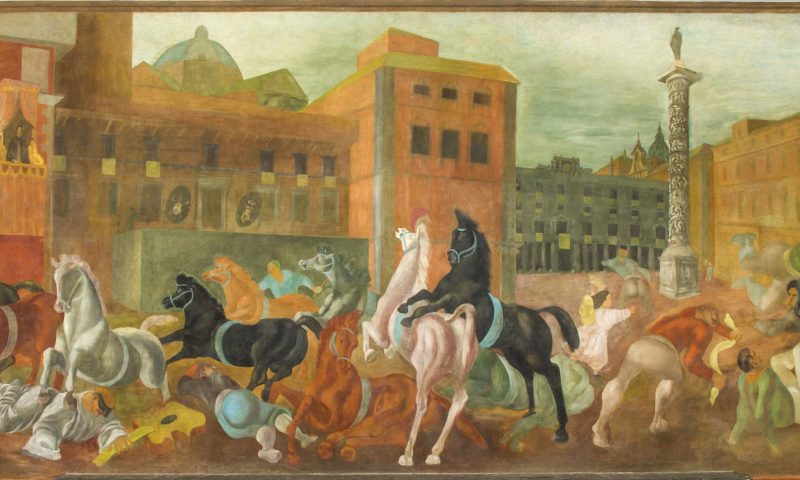RESTORATION OF CORRADO CAGLI’S “CORSA DEI BARBERI” HAS BEEN COMPLETED
THE EVENT
On Tuesday 12 December at 9.15 am at the Accademia Nazionale di Danza in Largo Arrigo VII, 5, in Rome, the restoration of the mural painting La corsa dei Barberi painted by Corrado Cagli in 1935 will be presented to the public.
Speakers include Lucia Chiappetta Cajola and Annamaria Galeotti, President and Director of the National Dance Academy (AND), Alessandra Marino, Director of the Central Institute for Restoration (ICR), Daniela Porro, Special Superintendent of Archaeology, Fine Arts and Landscape (SS-ABAP) of Rome, Stefano Pighini, Executive Vice President of LoveItaly and Gloria Arditi, Founding Member of LoveItaly.
The restoration – spearheaded by Ester Coen, former president of AND, to celebrate the seventieth anniversary of its foundation – is the result of the active collaboration between AND, ICR and the Special Superintendency of Fine Archaeology. Arts and Landscape of Rome. The Ruth Stanton Foundation of New York generously financed the intervention, with the collaboration of LoveItaly; the “Corrado Cagli” Archive and the archive of the “National Gallery of Modern and Contemporary Art” took part in the project. The restoration was carried out under the direction of the ICR by Cecilia Bernardini with the collaboration of Gabriella Gaggi and Daniela Milani.
The mural represents the famous riderless horse race held on Via del Corso to celebrate Roman Carnival; the term “Barbers” referred to the steeds originating from Barbary, a region of North-West Africa which included Morocco, Algeria, Tunisia and Libya.
The work was created in 1935 by Corrado Cagli, with the collaboration of Mirko Basaldella and Aldo Salvadori, for the library of Castello dei Cesari, renovated in a rationalist style by the architect Gaetano Minnucci for use as the headquarters of the Casa della Gioventù Italiana of Littorio.
The mural, judged unsuitable for the environment in terms of theme and style, was ordered to be destroyed by the Minister of Corporations Renato Ricci, but was saved by a false wall of plaster and reeds built by Cagli himself, removed in 1945 by Mirko Basaldella.
THE RESTORATION
The restoration is in line with ICR’s remit for techniques of twentieth-century mural painting, which also includes the restoration of the mural by Mario Sironi in the Aula Magna of the Rectorate of the University City (1935), designed and carried out by ICR with Sapienza University of Rome, concluded in 2017. La corsa dei Barberi, a figurative document of great importance in Corrado Cagli’s work and, more generally, in the context of Italian figurative art between the two wars, has been subject to various restoration interventions since the 1960s; ICR also carried out conservation operations in 1997 under the direction of Michele Cordaro. Its nature as a dry painting, executed on a dry wall with upper layers of tempera paint, makes it fragile.
Twenty years later, the consequences of past water leaks, solar radiation, the intensive use of the room for dance purposes, the deposits of atmospheric dust and the alteration of the materials from previous restorations lead to an impoverishment and alteration of the pictorial film which appeared detached in several places and at risk of falling. The current restoration addressed the problem holistically: as a preliminary step, diagnostic investigations were carried out, accompanied by environmental monitoring of the classroom for an entire calendar year. The Academy and the Superintendency of Rome carried out the renovation, waterproofing the terrace above the room and adapting the fixtures, with double glazing and anti-UV filters in compliance with the type of work.
The restoration of the painted wall involved the consolidation of detached plaster, where necessary; the restoration of surface continuity to the pictorial film, at risk of falling, through re-adhesion and cohesion operations; cautious cleaning and the removal of bleach and alterations from the previous restorations; the removal of old fillings with a scalpel; the sealing of gaps with new, more suitable material; and the reinstatement of the pictorial film. Innovative materials, previously tested in ICR, were also used. To give back the correct reading of the figurative painting, as supported by studies and documentary research, tone glazes and vertical hatching techniques were used to integrate the pictorial film, alternating paint with watercolour and water-soluble pastels
As usual for ICR, a multidisciplinary group of technicians was involved in the restoration: architects, art historians, restorers, chemists, physicists, biologists, photographers. In addition, the expertise of ICR Laboratory of Chemistry and Material Testing, the Department of Chemistry and Industrial Chemistry of the University of Pisa was involved.
Before and during the process, the mural became the subject of the thesis of a student at ICR in Rome, candidate for the qualification of restorer of cultural heritage (LMR/02).
ISTITUTO CENTRALE PER IL RESTAURO
Working group
ICR Director: Alessandra Marino
Coordination and Works Management: Laura D’Agostino (art historian), Paola Mezzadri (restorer).
Fabio Aramini (physicist), Marco Bartolini (biologist), Carlo Cacace (physicist), Donatella Cavezzali (architect), Lucia Conti (geologist), Rocco D’Urso (surveyor), Edoardo Loliva (photographer), Cristina Lollai (art historian), Barbara Provinciali (restorer), Giancarlo Sidoti (chemist), Cristina Udina (architect).
Thesis
Candidate: Giovanna Morricone 65th ICR SAF course in Rome, PFP1 (Professional Training Path 1: stone materials and derivatives – decorated surfaces of architecture), a. to. 2018 – 2019.
Title: “The Barberi race by Corrado Cagli: study of the execution technique, interaction with the environment and restoration of sample areas”.
Thesis advisor: Paola Mezzadri


